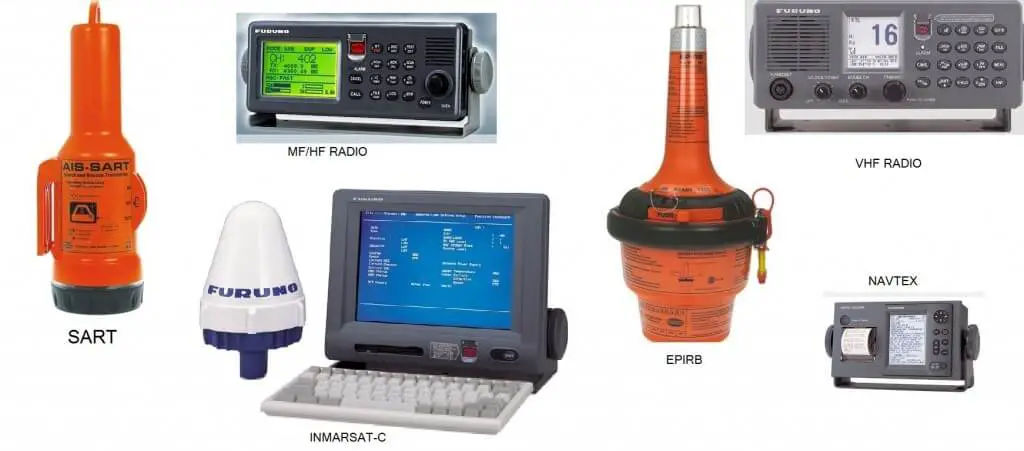The GMDSS radio equipment requirements are categorized as following:
- General
- Sea area A1
- Sea areas A1 and A2
- Sea areas A1, A2 and A3
- Sea areas A1, A2, A3 and A4
Radio equipment: General
Every ship shall be provided with:
- VHF radio capable of transmitting and receiving:
-DSC on the frequency 156.525 MHz (channel 70) and maintain a continuous watch on the same -Radiotelephony on the frequencies 156.300 MHz (channel 6), 156.650 MHz (channel 13) and 156.800 MHz (channel 16);
- A search and rescue locating device (SART) capable of operating either in the 9 GHz band or on frequencies dedicated for AIS
- A receiver capable of receiving international NAVTEX service broadcasts if the ship is engaged on voyages in any area in which an international NAVTEX service is provided;
- A radio facility for reception of maritime safety information by the Inmarsat enhanced group calling system (EGC)
- A satellite emergency position-indicating radio beacon (satellite EPIRB) which shall be:
- Capable of transmitting a distress alert through the polar orbiting satellite service operating in the 406 MHz band;
- Ready to be manually released and capable of being carried by one person into a survival craft;
- Capable of floating free if the ship sinks and of being automatically activated when afloat; and
- Capable of being activated manually.
In case of passenger ship shall be provided with means for two-way on-scene radio communications for search and rescue purposes using the aeronautical frequencies 121.5 MHz and 123.1 MHz from the position from which the ship is normally navigated.
Radio equipment: Sea area A1
Every ship engaged on voyages exclusively in sea area A1 shall be provided with the minimum equipment specified above in requirements of category General.
Also in addition, every ship engaged on voyages exclusively in sea area A1 shall be provided with a radio installation capable of initiating the transmission of ship-to-shore distress alerts:
if the ship is engaged on voyages within coverage of MF coast stations equipped with DSC, on MF using DSC; or on HF using DSC.
Radio equipment: Sea areas A1 and A2
Every ship engaged on voyages beyond sea area A1, but remaining within sea area A2, shall be provided with the minimum equipment specified category General, in addition:
- An MF radio installation capable of transmitting and receiving, for distress and safety purposes, on the frequencies: 2,187.5 kHz using DSC; and radiotelephony and maintain a continuous watch on it.
- The ship shall, in addition, be capable of transmitting and receiving general radio communications using radiotelephony or direct-printing telegraphy by either:
– a radio installation operating on working frequencies in the bands between 1,605 kHz and 4,000 kHz or between 4,000 kHz and 27,500 kHz. This requirement may be fulfilled by :
A HF radio installation or an Inmarsat ship earth station
Radio equipment: Sea areas A1, A2 and A3
1 In addition to meeting the requirements of category General above, every ship engaged on voyages beyond sea areas A1 and A2, but remaining within sea area A3, plus:
a. An Inmarsat C ship earth station
b. An MF radio installation and 2187.5 kHz DSC watchkeeping receiver (can be the same one as required for A2);
OR
a. An MF/HF radio installation capable of transmitting and receiving on all distress and safety frequencies in the (marine) bands between 1,605 kHz and 27,500 kHz using DSC, radiotelephony and NBDP.
b. An MF/HF DSC watch keeping receiver capable of maintaining DSC watch on 2,187.5 kHz, 8,414.5 kHz and on at least one of the distress and safety DSC frequencies 4,207.5 kHz, 6,312 kHz, 12,577 kHz or 16,804.5 kHz; at any time, it shall be possible to select any of these DSC distress and safety frequencies
AND
Ships shall be capable of transmitting and receiving general radio communications using radiotelephony or direct-printing telegraphy by an MF/HF radio installation operating on working frequencies in the (marine) bands between 1,605 kHz and 27,500 kHz. This requirement is normally fulfilled by the addition of this capability in the MF/HF equipment referred to earlier – there is no MF only equipment made.
Radio equipment: Sea areas A1, A2, A3 and A4
In addition to carrying the equipment listed previously, every ship engaged on voyages in all sea areas shall be provided with:
An MF/HF radio installation and DSC watchkeeper as described earlier
In addition, ships shall be capable of transmitting and receiving general radiocommunications using radiotelephony or direct-printing telegraphy by an MF/HF radio installation as described earlier.
Maintenance Requirements (SOLAS Ch IV, reg 15)
Means of ensuring availability of ship station equipment:
1.At sea electronic maintenance, requiring the carriage of a qualified radio/electronic officer (holding a GMDSS First or Second class Radio-Electronics Certificate) and adequate spares and manuals;
2. Duplication of certain equipment
3. Shore based maintenance
Ships engaged on voyages in sea areas A1 and A2 are required to use at least one of the three maintenance methods outlined above, or a combination as may be approved by their administration.
Ships engaged on voyages in sea areas A3 and A4 are required to use at least two of the methods outlined above.
Equipment to be duplicated for area A3 vessels :
GMDSS ships operating in A3 areas are required to provide the following duplicated equipment;
Two complete VHF installations (including DSC),
AND
Two complete Inmarsat C systems and one MF radio system
OR
One complete Inmarsat C system and one complete MF/HF radio system (including a scanning DSC receiver and NBDP equipment).


Leave a Reply